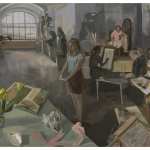I have a writing deadline this week so posting will be scant, but I came across an interesting 2003 Bomb Magazine interview between Joe Fyfe and French painter Bernard Piffaretti that I had to share. Here’s an excerpt.
Bernard Piffaretti, Untitled, 2001, acrylic on canvas , 59�39 3/8.” Courtesy of the artist and Cheim & Read.
When: Nov. 24, 2003
Where: In the studio, 11 rue Bichat, Paris
painting the plane is where a transition takes place, where the tableau
is porous and the viewer�s point of entry is broken up.
had a relation to simplicity; it is about fact, not effect. This is not
because of nationality, but part of the traditional attitude is about
continuity. Matisse�s Red Studio is simple�it�s an attitude, what Eric de Chassey called a �decorative violence.�
JF In the Matisse/Picasso exhibition [on
view in Paris at the time], I was surprised to see that expressionism in
Picasso�s hands felt like a cabinet drama, while Matisse�s breaking of
the larger, decorative language of painting and his awareness of the
breadth of light and color on a surface seemed very modern. Speaking of
languages, I am wondering about the title of your 2000 exhibition at the
Cartier Foundation, Va-et-vient (Come and Go). I am told this is French
sexual slang, which led me to think that your work examined the
mechanistic aspect of making a painting, as if the act of painting drew
from a set of responses, like sex does to a certain extent.
short play of the same name by Samuel Beckett. Three people in similar
dress share a bench. One leaves and another arrives; the permutations
and combinations continue for a prescribed period. This pertains to my
work inasmuch as the difference between the painting and the viewer is
that the painting always has an active attitude, it is always
unfinished: a quality of the practice of painting itself. This daily
attitude is banal; it�s the opposite of contemplation. The critical
moment in making my paintings is the first mark down the middle, which
declares, THE SURFACE IS HERE. It is produced very calmly, but it is
violent and immediately negates the authority of the tableau, making all
the aesthetic decisions unimportant by becoming a simple fact that the
first situation will be redone. The quality of subjectivity breaks down.
Redoing is a negation of series, of origin. This central mark refers to
the emblematic situation of Matisse when he said, �It�s not a woman;
it�s a painting.� The image an artist paints begins to have the attitude
of image painting; it�s not just the expression of the artist. My
definition of the tableau goes back to the origin of the word, tabula,
table in Latin. You move things around on a table arbitrarily, without
necessity. The stuff is just there, ready to be acted on.
JF Your paintings remind me of two pages
of an open book, like Jasper Johns�s 1976 painting End Paper. The
repeated image literalizes the painting. Another instance is Johns�s
painting Fool�s House [1962], which has BROOM written on it
and a broom attached. In many of your paintings, the patterns seem to
nod toward the harlequin, an early modernist theme. This clownlike
element is in some Beckett characters, too.
















